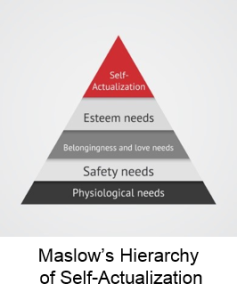Most sales training programs spend little time focusing on pre-call planning. These programs suggest that you use the list of customers supplied by the company. But, has anyone examined the list and determined if time with these prospects is the best use of your time and talent as a company resource? Often there is little connection between the marketing department and the sales department. In fact, they are often independent silos. This fact is documented in the findings of the Sales Executive Council and their interview of thousands of companies as well as the research by Neil Rackham, best-selling author of SPIN Selling.
Planning the Atmosphere The key to getting people to spend time with you is making the other person feel important and that you have something of value to offer in the way of knowledge or insight. Notice how high the need for esteem sits on Maslow’s Hierarchy of Needs Chart. Knowledge of the person and their company along with the proper approach can accomplish that objective.
The key to getting people to spend time with you is making the other person feel important and that you have something of value to offer in the way of knowledge or insight. Notice how high the need for esteem sits on Maslow’s Hierarchy of Needs Chart. Knowledge of the person and their company along with the proper approach can accomplish that objective.
The advice from Dale Carnegie and the example set by people like Teddy Roosevelt demonstrate the value of knowledge of the other person, the role they play and making them feel valued.
Pre-call planning will allow you to identify the best prospects and to gather valuable information about them and their company. With that information you will be prepared with insight and the ability to connect the dots between your company’s product and your customer’s needs or opportunities.
Where Stories Fit
Prospects will spend time and accept your insight if you establish trust and you demonstrate an understanding of them and their needs. Stories are a non-confrontational way to connect with prospects and demonstrate that you have done your homework. Good stories allow prospects to build on them and co-create the solution. It is often during co-creation that the best ideas are born and the insight comes alive. The result is co-ownership and the prospect wants the outcome to succeed.
When to Move Suspects to Prospects
As a salesperson you have a finite number of hours in the business day and your time must be spent with the best prospects to maximize your productivity and income. Below are some critical questions that you need to answer before you move a company from your list of suspects to the list of targeted prospects.
Critical Questions
- Does the suspect’s industry or line of business make them eligible for your product or solution?
- What does your company offer and how does it or will it benefit the suspect?
- What current trends in the industry affect this suspect?
- What is the impact of those trends on the suspect?
- What political or economic changes have occurred that affect the suspect?
- Is the suspect eligible financially for your solution?
- Has there been a change in the company organizational structure?
- What do you know about the executives – education, work history, track record, alliances, recent articles or interviews?
- Who is the target of your call? Why? What is their role in the organization? What do you know about their goals or motivation?
- Have you sourced and reviewed public information – annual report, Barron’s or Barron’s online, MSN Business Online, OneSource, Standard & Poor’s, U.S. Securities and Exchange Commission, industry periodicals, industry association information, and the company website?
- Based on your research what insight can you offer to the suspect?
- Has there been a change in the competitors?
Planning Your Strategy
Once you have identified the appropriate targets, you’re ready to plan the preliminary strategy and the initial contact. These elements should not be totally rigid as that would force the prospect down a specific path and you may miss an opportunity. However, you should plan a general direction and key questions to fill in the missing pieces in your view. It is also important to anticipate the prospect’s questions and have prepared an answer. The interaction should be conversational. Therefore, it isn’t a good idea to memorize specific responses but rather know content for a response that will keep you in control of the situation and able to guide the direction of the sale
What Stories to Use
It’s a good idea to have a collection of stories so you can have a few in mind that might fit the anticipated conversation. For example, a “who you are and why you are there” story provides the prospect with information on your knowledge and credibility as well as why you selected them. “Why you are there” stories show that you’re not there for personal gain but because you feel passionate about the idea or product. Think about your sense of fulfillment in a past success or the joy of seeing a client embrace a new idea.
 It is very important that the conversation is about the prospect’s business and not winging it through the call or directing the conversation to the features of your product. The suspect can check features and specifications on-line at the vendor website.
It is very important that the conversation is about the prospect’s business and not winging it through the call or directing the conversation to the features of your product. The suspect can check features and specifications on-line at the vendor website.
As final note on planning, ensure that you expand your knowledge of typical customer business types and the decision makers in each key role. You also want to consider how you might offer a teaching story to educate the prospect on a new technology, new strategy, or new way of viewing processes. Sales are won on a journey to a solution built on a solid foundation. Time spent in pre-call planning is repaid many times over along the journey to your financial goals.



